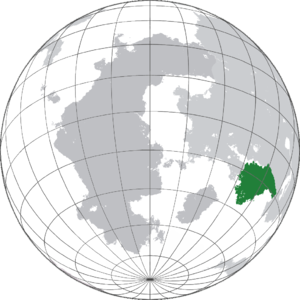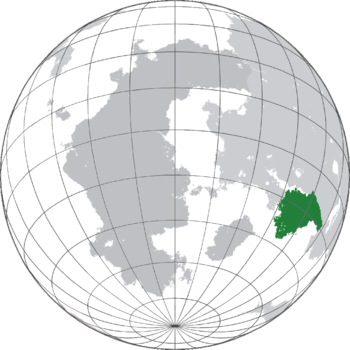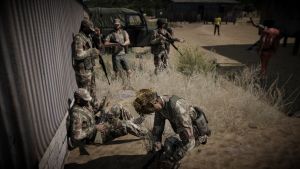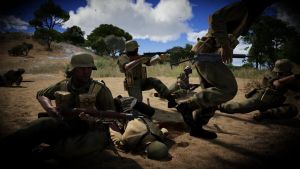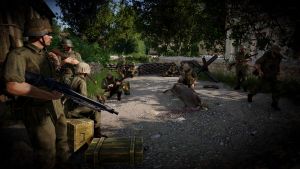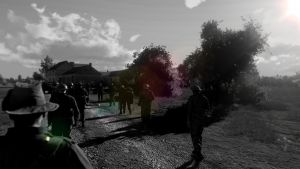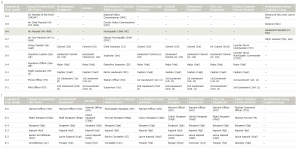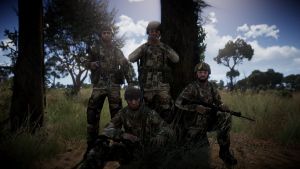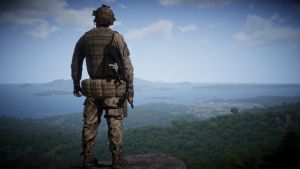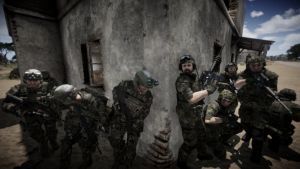The Armed State Of Verkimlund
The Armed State Of Verkimlund Die Gewapende Staat Verkimlund | |
|---|---|
|
Flag | |
Motto: "Vir die goeie van al" "For the good of all" | |
Anthem: Verkimlund Stands March: March of the Verkimlund Regiment | |
| Location | Verkimlund makes up much of the south western coast of Cancodia. |
| Capital and largest city | Salisbury |
| Official languages |
|
| Recognised regional languages |
|
| Ethnic groups | |
| Religion |
|
| Demonym(s) | Verkimlunder |
| Government | Parliamentary Democracy |
| Peiter Koch | |
| Ian Holder | |
| Legislature | Housevaaler |
| Kings Court | |
| Tribal Council | |
| Establishing Events | |
• Dolphik Colonisation | 1792 |
• Signing of the Charter Of Self Rule | 1893 |
• End of the Confederation | 1920 |
| Area | |
• Total | 100,000 km2 (39,000 sq mi) (N/A) |
• Water (%) | 5.7 |
| Population | |
• April 2021 estimate | |
• 2021 census | 81,250,000 |
• Density | 45.45/km2 (117.7/sq mi) (3rd) |
| GDP (nominal) | 2021 estimate |
• Total | |
• Per capita | |
| Gini (2021) | low · N/A |
| HDI (2020) | high · N/A |
| Currency | Rand (VRD) |
| Date format | dd/mm/yyyy |
| Driving side | left |
| Calling code | +800 |
The Armed State Of Verkimlund, formerly The Confederated Dominion Of Verkimlund And Teleland, commonly known as Verkimlund, is a sovereign nation in south west Cancodia. The nation includes the States of Kettalli, Transvaal, Nurt Cape, Tetlebele, and The Cape. The nation shares a land border with Traestan on its north western face and a land border with Nostrapais on its eastern side, to its south is the Vozun Ocean. The union of Verkimlund and Teleland (The greater collection of Kettali and Telebele) was signed into law in 1893 with the Colonial Communion Act of the same year. The small nation boosts a reasonable military for its size and wealth due to a long running tradition of National Service particularly among minority groups. Verkimlund is a signed Member of the International Trade Sphere aswell as International Space Cooperation Program. Exports from the nation are largely Raw Minerals and Small arms sold to private individuals.
Etymology
The Name "Verkimlund" Roughly translates from Verkim To "New Land" but older texts of Verkim settlers actually translate it to "Our Land" Taken litterally the name translates to "Land of Verkim" which has led to some controversy among non Verkim Speaking Populations of the nation
History
Precolonial History(?-1750)
Arrival of Dolphik Settlers(1752)
Traveling aboard the HMS New Hope, Captain Thomas Seafourth, a captain of the Royal Navy, Originally sighted The coast of Verkimlund in 1750 while mapping the Vozun Ocean for Royal Navy Charts, Originally thought of only as farmland and gazing grounds exploration groups set out to evaluate the land for the growing of crops in demand in Dolphikland at the time, these groups eventually reached what would later be named the Nurt cape where they found an abundance of Gold and other Raw Minerals. Six years after the first group landed in 1758 an authorised effort led by Paul Valber landed on The Cape establishing a Colony at Wekeland, in the south west of the Verkimland Plain's work began to build the necessary infrastructure to allow mining and feeding of the mining population, To allow this to happen without needing to use local, illiterate and non dolfik speaking labour, prisoners from the mainland were utilised as labourers, these labourers coming from industrial canters and criminal backgrounds began using Local Theives Cants from around Dolifkland to communicate without the knowledge of their Dolphik guards, this would evolve and soon became what would be recognised as Verkim.
Establishment of the State Capitals (1755)
Across 1755 Multiple Attempts were made to establish additional Colonial Settlements in order to find and exploit further natural resources within the nation, the most successful of these being the settlement of Salisbury which utilised Existing Verkim Labourers from Wekeland and Estvel that was the first endeavour in the nation to use largely native Manpower from the local population compensating the Local Kraals for their effort with food and resources taken from the Wekeland Mining endeavours.
Kettali Range Skirmish (1759)
In late 1759 Miners on the Kettali Range, Fired on Kettali Tribesmen killing 3 when they attempted to move the miners away from a nearby kraal that the miners did not have knowledge of at the time, it was believed at the time that the Tribesmen, who numbered between 50 and 60 from sources from the period were mounting an attack, after a single volley the skirmish ended with the Kettali retreating from the field, the kraal similarly was abandoned at some point shortly after.
The Dolphik-Kettali War(1760-1765)
In early 1960 under the command of Paul Valber, the Wekeland Garrison, comprising of 1 company of Verkim Milita marched to their mining interests in Kettali under the flag of the Dolphik Crown to address concerns of Native Retribution for the earlier Kettali Range Skirmish, The force made Camp at Seleko before marching on towards the New Adnburg Mining Purchase the next morning, during that night on the 3rd of January 1760 Kettali Braves attempted to ambush the column in camp, killing Paul Valber and 17 Men under his command before being repulsed by the remaining force now under the command of an acting Lieutenant. The resulting war, being fought largely by Verkim Volunteers and Dolfik Officers lasted a little under 5 years and resulting in the Kettali Nation being severely cut down in size aswell as the increase of prison population to afford replacement labourers for those who had volunteered to fight.
The resulting logistical situation saw rise to the first generation of Verkim Rangers, Prison labourers given bond to build a home along well worn supply lines and mining routes, to patrol and secure the route from both wildlife and Kettali raids, Outside of the Parliament building in Salisbury one such ranger is immortalised looking over the square from horseback in the form of the ranger monument. While no official record was kept of the numbers of such Rangers, the houses built along such routes still exist and suggest numbers from between 1,000 and 3,000 during the period of the Kettali War.
The Verkim Rebellion (1795-1799)
In 1795 the decision was made to reduce the numbers of Verkim Prisoners working in the colony and to bring several of the originally transported groups back to prisons in Dolfikland, including many of the prisoners who now made up the Verkim Rangers, an organisation that had expanded to not only protecting the routes of commerce and mining tracks, but now also served as impromptu rural police and mail carriers, having been given bond to establish homes and communities by the authorities of the Verkimlund colony, many of these rangers openly rejected the call back to port, gathering many others both rangers and otherwise to their cause numbering nearly 6,000 men at arms at the rebellions height in 1793. in 1795, they marched on Salisbury, the then declared capital of the colony, with a force numbering around 300 men led by a ranger known as Ian Vestergild the garrison, made up mostly of verkim quickly turned to their cause and took up arms alongside them bringing there numbers in the then township upwards of 500 men. Vestergild, realising correctly that such a position could not be held against a superior force left the captured territory, taking its stores of shot and powder and led his force into the nurt cape where they fought a guerrilla campaign for the next 4 years, After the rebellion ended with the battle of Seleto Ridge, Vestergild was put to death as a traitor. His force of 3,422 Rangers however were allowed to remain in the nation with an extension to their sentences, most choosing to join the Company Militia in the coming years on a deal for veterans of the rebellion to gain commission as officers.
The rebellion ended the practise of bonding rangers for good in the nation until the advent of the kettali rangers in 1937, the rebellion also put an end to the practice of using prison labour in the colony due to concerns of additional popular uprisings even larger than that of the rangers, should the larger mining population choose to rebel it was reasoned that a far larger and more costly guerrilla campaign could be fought on the same ground for far longer.
Company Rule (1799-1852)
In 1799 Operation of Verkim mining interests was handed over to the Chartered South Coast Company. A Chartered Company formed of selected Merchant Navy officers. At the time it being believed in dolfik mining circles that the creation of a relationship similar to mining communities at home was preferable to the continued use of unwilling prison labour prone to rebellion. As such control not only of the import and export of the colonial holding, but also daily administration of the land was handed to the company. This included administration of the nations Prison workforce. These prisoners had their sentences redefined, no longer preforming hard labour as part of their sentence but instead where merely confined to the nation itself, free to work as they saw fit within the nation. The company not only offering wages for the work they had previously done uncompensated but providing housing and limited medical services. While the wages were low and the housing of poor quality, the comparable luxury afforded them by the company compared to the hard lives lived under His Majesties Prison Service led to a period of mostly peaceful profit for the dolfik crown.
Initially The duty for defending the holding fell to the normal authorities for such work, but as the working population of the holding grew under the company and townships expanded in size, hostilities with native populations grew. On multiple occasions open warfare was narrowly avoided however skirmishes and raids quickly became concerning, with the established network of mounted colonial police being unable to guarantee the safety of the citizenry let alone the mining interests the authority to raise a Militia was afforded to the company, raised mostly of Verkim transportees with an officer corp of ex-dolfik army and old Verkim Rebels, a militia was raised for each major settlement, with Conscription being uncommon but necessary in certain locations, namely Estvel where the population simply was not big enough to raise a volunteer force of company strength.
While Company Rule was a highly profitable endeavour it quickly became clear that, while highly profitable for the Company, its continued costs, paying an ever increasing number of workers requiring and ever increasing amount of infrastructure, an ever increasing number of ships used to transport goods to and from in addition to the ships required for defence, all being paid for by dolfik state coffers quickly became an ever mounting list of expenses that while still easily covered by the profit the land afforded, would if left unchecked run wild.
Direct Rule (1752-1893)
In 1752 Dolphik Parliament passed the "Chartered Companies Act 1752" Taking direct responsibility for the responsibilities, debts, wages, and authority of the company. In effect taking ownership of all the assets of the collective company at the time of the acts passing, with officers of the Merchant Navy returning to their posts. almost immediately the crown formed a local authority for the holding, creating the Verkimlund Colonial Office, recognising for the first time the name given to the land by its inhabitants who by now were largely immigrants from Dolfikland or the descendants of those sent before them. This Colonial office set to work an immense campaign of investment, Expanding large townships like Salisbury into city's, building hospitals and Facilities using the income that now went directly to the running of the state rather than to the shipping of resources.
This direct rule government saw a period of immigration from Native regions of the nation, this prompted a period of rapid and largely military exploration of the Kettali land, largly by Scout elements of the newly formed Kaisers Verkim Legion, this exploration saw a new period of diplomacy between Verkim and Kettali populations, with the Colonial Office paying for multiple diplomatic missions including intervention in Tribal warfare within the Kettali lands, such intervention normally featured petty arbitration, but in 1801 a campaign of direct military involvement brought much of the Kettali land into Verkim control. This control was largely a hands off approach but the promise of hefty investment and the training of Kettali kraal militia brought a number of eastern kraals under the control of the Colonial Office, by 1820 the Kettali region was considered as part of the main nation, and the Colonial Office completed the construction of a network of routes through the bush to interconnect the Cape-Kettali Region
This period also saw the Signing of the Tetlebele Agreement in 1821, joining the small nation of Tetlebeleland to the larger state as a sovereign state. Period documents show that this agreement was signed under the threat of invasion by Neighbouring Kettali Kraal Militas armed and Trained by the Colonial Office as part of a separate agreement with the Cape-Kettali to aid in the defence of the Kraals from one another. While the Cape-Kettali Expansions Progressed Quickly and allowed far more lucrative Mining interests to be opened using local workforces and defended by local militias however the combined expansion of mining efforts and Verkim military forces led to accusations of profetering by elements of the Kettali in the region that became known as The Main. Expansion into The Main was A slow and diplomatically painful endeavour involving numerous kraal wars backed by Verkim Allied Kraals in the region by the end of 1880 The Main fell in line with the rest of the nation and made up most of the population, however, seeing opportunities for wealth and education in the Cape, the population centers of Verkimlund would shift to the Cape and Cape-Kettali by the turn of the century. Legally the status of the Kettali was the same as any other verkim citizen at the time, with a landed voting system. At the time no legal or institutional ruling preventing Kettali from taking part in the administration of the nation, however by the time of Self Rule in 1893 no Kettali national sat in any position of power, and short of the Kaisers Kettali Legion, established in 1882 no Kettali sat in command of troops within the military forces of the Colonial Office. In 1884 Ian Dokval Rose to the position of Colonial Governor replacing his Dolfik Predecessor, seeing the lack of Kettali involvement in the administration of the nation as a waste of valuable resources, with Kettali and Cape Kettali being organised by Dolfik Officials he set out to create a council of Large Kraals that could administrate the Kettali regions without needing Dolfik Supervision, this this end the Tribal Council was created from the largest contributors to security in the Kettali and Cape-Kettali Regions, by the end of the Direct rule Period the Colony, Under Ian Dokval was almost entirely self sufficient, With only Token Dolfik involvement in the form of Liaisons and Customs officials, The Colonial Military had expanded to be more than able to defend itself, volunteering for foreign service with the Greater Dolfik Army of the day. and numerous institutions had arising from the Dokval Leadership, Localised Fire Departments, and A national Colonial Police Service had replaced the Militia system of old. This new self Sufficient structure would lend itself well to the continued prosperity of the colony and unintentionally laid the ground ship for future reforms to legislation and policy.
Self Rule (1893)
The Colonial Office was Disbanded in 1983 and replaced almost immediately by what would become the National Government established by the Charter Of Self Rule, signed in 1893 which created the Confederation of Teleland and Verkimlund an impromptu arrangement designed to placate what was at the time an apprehensive Kettali population by offering the same legal status as Teleland, however the attempt proved unsuccessful and in 1920 the legal status of Teleland was revoked, with the tribal council taking its place in the legislature, while Legally still bound to the Dolfik Crown and owing tithe to the crown as such the government of the new nation was largly free to act as it wished and did so frequently rewriting and outright nullifying Dolfik laws left over from Direct rule, there were multiple such attempts, particularly from parliament who notably tried and failed on two attempts to remove the legal authority of the dolfik crown before succeeding in 1920
End of the Confederation (1920)
The end of the confederation came about from a mixture of discontent at home, and international pressures, particularly from Kerthenia who not only drafted but ratified the charter of self rule Previously, no specific date or time marks the exact end of the confederation but most accounts mark it as 1920.
Great war (1917-1934)
Verkimlund Bush War (1945-Present)
Baydorian Conflict (Present)
In late 2020, conflict arose between the allies of Barkadia and the Dolphik Commonwealth, Sparking a constitutional Crisis in Verkimlund, Caused by the outbreak of the Baydorian Civil war, and Dolphik intervention against communist guerillas in the region, Barkadia became involved upon their recognition of the Baydorian Communist party as the Rightful Government of Baydor. Housevaaler at the request of Prime Minister Pieter Koch, Reaffirmed their commitment to the Independence convention and declined to join the war on either side, signing into law a Neutrality Agreement for the duration of the conflict. With the Assistance of East Kara's Air force, Verkim Forces sent to join the Initial Intervention force were recalled.
Operation Paveway
Shortly after the Singing of the Neutrality Act Internally, the Prime Minster went before the house and proposed plans to purchase crown land for the use of treating Commonwealth casualties to satisfy the nations debt to the commonwealth that the nation could no longer uphold by military means, However, when the plans were approved the Prime Minister announced plans to expand this Effort with Operation Paveway, a military, diplomatic and humanitarian effort to transform large parts of the crown lands, locations without Cultural, or Wildlife Considerations, or locations in which the Local Kraals Offered the use of their land IE, Teleland to be used for the construction and future administration of the largest Humanitarian effort In International History, with new Hospitals, Airfields, JOCs, and support facilities, build in quick order using Prefabricated blocks and internationally supplied materials, and Personnel, the Operation presented to parliament originally, featured Full scale Martial Law in Key Areas, Namely Salisbury, and Estvel, but was scaled back to Salisbury International and Estvel Harbor exclusively. this plan Initially was a entirely internal Affair, expecting to open for commonwealth causalities within the month, with full operation within a year.
It quickly became a concern that should Humanitarian aid be exclusive it would set a precedent for future conflict and thus a second neutrality act was drafted, Ratified by Ambassadors from Anderia, Barkadia, Dolphikland, Lorbs, and Tunguska, this Act established a recognized state of safety in and around Verkimlund, with dedicated and Protected shipping and air routes, for the evacuation of casualties from both sides in the conflict, Pieter Koch also wrote and traveled to as many nations as possible, both combatants and none combatant nations asking for Personnel, both civilian and military for this effort. by the start of operations, The following organizations had been created and were operating by the end of the year as planned. International Support was organized into a task force structure for allocation of resources and effort, organized largely by the Army logistics Regiment.
Task Forces Present
Task Force Aegis (Logistics and Shipping)
- Task Force Aegis, A Company (5th Task Force Barkadian Navy | Barkadian Air Force | Barkadian Merchant Navy)
- Task Force Aegis, B Company (46° Air Brigade, Serrian Air Force, Sansinni AFB | 65° Air Brigade, Serrian Air Force, Qazan AFB, Tau Kicar | 12° Air Brigade, Serrian Air Force, JB Draghi, Ametà | Agios Milita Air Self Defence Force 29 AEF | 7° Air Brigade, Serrian Air Force, P'voshi AFB, Yeristan )
- Task Force Aegis, B Company, Supplimentary (The Noble Order Of Serria | 221° Expeditionary Civil Engineering Squadron, Sansinni AFB, Serria | 118° Expeditionary Prime Base Engineer Emergency Force, Hasita AFB, Edusa)
- Task Force Aegis, C Company (Tau Kicari Air Force, 317 AEF)
- Task Force Aegis, D Company (Malabar Navy 2nd Task Force)
- Task Force Aegis, E Company (Tungustian Army, 2nd Expeditionary force)
- Task Force Aegis, F Company (PLACEHOLDER SUNC)
- Task Force Aegis, G Company (PLACEHOLDER DOLPH)
- Task Force Aegis, H Company (PLACEHOLDER ANDO)
- Task Force Aegis, I Company (1° Task Force, Royal Verkim Navy | Verkim Security Forces 1°Humanitarian Effort)
- Task Force Aegis, J Company (33rd/43nd Air Lift Squadrons, Zkavkoza Air Force | 2nd Air Cavalry Battalion, Zkavkoza Army)
- Task Force Aegis, Civilian Contingent
Task Force Invictus (Evacuation and Transport)
- Task Force Invictus, A Company (4th Wing Barkadian Air Force)
- Task Force Invictus, B Company (46° Air Brigade, Serrian Air Force, Sansinni AFB | Agios Milita Air Self Defense Force 29 AEF, No1 Wing)
- Task Force Invictus, C Company (Tau Kicari Air Force, 317 AEF, No2 Wing)
- Task Force Invictus, D Company (320th Naval Air Squadron, Malabar Air Force)
- Task Force Invictus, E Company (No3 Air Wing,TAF)
- Task Force Invictus, F Company (PLACEHOLDER SUNC)
- Task Force Invictus, G Company (PLACEHOLDER DOLPH)
- Task Force Invictus, H Company (PLACEHOLDER ANDO)
- Task Force Invictus, I Company (C Squadron VSAS, 2° Humanitarian Effort, Verkim Security Forces)
- Task Force Invictus, Civilian Contingent
Task Force Aurelius (Medical And Military Personnel)
- Task Force Aurelius, A Company (Barkadian Volunteer Contingent | Barkadian Army Medical Corp, 2nd Detachment)
- Task Force Aurelius, B Company (4° Medical Group, Serrian Army, Naval Support Facility Port Vellina, Serria | 6° Medical Group, Serrian Air Force, JB Montecchio Nord, Estia | Agios Milita Air Self Defense Force 29 AEF, No1 Wing)
- Task Force Aurelius, C Company (Tau Kicari Air Force, 317 AEF, No2 Wing | Agios Milita Air Self Defense Force 29 AEF, No1 Wing)
- Task Force Aurelius, D Company (PLACEHOLDER SUNC)
- Task Force Aurelius, E Company (PLACEHOLDER DOLPH)
- Task Force Aurelius, I Company (Verkim Army Medical Corp)
- Task Force Aurelius, Civilian Contingent
Verkimlund extended an offer to all those who came to assist a full Military Wage consistent with equivalent military rank, most military's declined for political reasons but Civilian Volunteers where not offered the choice, receiving a Troopers wage, and Pension, a decision from the Prime Minister that Parliament lashed against for economic reasons. Military Formations operating under this banner acted within their own structure within the greater structure of their task force, where possible Companies from warring nations where kept separate but this was not always operationally possible.
Established Facilites
Estvel
Gramthem House, a Royal Household owned and maintained by the Verkimlund Government was converted and its estate seized for conversion into Medical Faculties when operations expanded to include "OPFOR" casualties, the faculties quickly became one of the largest, due to the need to construct new barracks on the estate for Staff and Patients, the facility filled with internationally provided equipment quickly became the best provisioned in the nation and most likely in the region.
Salisbury
Salisbury International, once a Joint Civilian-Military Airport, was seized entire for Military flights, acting as the main artery for the flow of equipment and casualties, with an expanded hanger pool and onsite ambulance service being constructed, civilian flights were diverted to Estvel Airport, a second airport is being constructed in Salisbury to act as the civilian hub for travel.
Teleland
After the conversion of Salisbury international the Kraal council of Teleland once more stepped forward to serve, as they did with the expansion of national service, Offering the use of their land for medical facilities, In addition to the military faculties, a Ranger station and local hospital were constructed on site, not as well provisioned as the military site, but better than the local ambulance service it replaces.
Government and Tribal Rule
Housevaaler and Parliment
Government In verkimlund comes from the majority party of Housevaaler, currently the National Security Alliance Lead by Pieter Kock, this is a coalition of the National Front, and Liberal Party. The majority party elects a leader to act as prime minister who then selects his minsters from Housevaaler and tribal council, traditionally the tribal council will reject any others of ministerial responsibility due to the responsibility they face within their tribal nation Housevaaler is the primary house of parliament, Traditionally serving the Dolphik and Verkim landowning populations of the nation but now serving any area within the land of the nation not held by the tribal reserves, with one representative elected for every area of 10,000 citizens (Counted as one citizen per occupied household).
Government in Verkimlund was functionally an extension of the Dolphik kings authority during the age of colonisation, and in hounour of this legacy the flag of Dolphiland flys above the building of Housevaaler when the house is not in session being replaced by the national flag when the house enters session.
The Tribal Council
The Tribal Council is made up of the tribal elders of each of the 27 recognised tribal nations but could in theory expand to incloud any of the 3 currently unrecognised tribal nations upon the reserves should the council vote to include them. Requirements for membership in the Tribal Council Incloude, A Tribal militia Subservient to and armed by the Verkimlund Government, A Definitive Single Organisation or leader with authority over the tribal nation, Acceptance by a majority of the current members of the tribal council.
The Tribal Borders
The Company Agreement
The Nurt cape Consession
Citizenship Commitment
National Service Expansion
Foreign Policy
The Dolphik Extradition Incident (2015)
The Foreign Fighter Act (1978)
In April 1978 The Tribal Council approved the Foreign Fighter Act. Entering into Verkimlund Legislation in december of the same year. The act serves to raise Sentences and add additional offenses specifically for fighters who travel from foreign nations to further the cause of Terrorist groups operating in Verkimlund, This is not exclusive to Fighters holding foreign citizenship, and includes several offenses designed specifically to be applied to native fighters travelling out of the nation in order to carry weapons and supplies such offences falling under the purview of those "Traveling from a foreign nation to further the cause of terrorist groups". The act faced criticism in Housevaaler for being to all encompassing, and many suggestions were made to split the act into two separate acts, one for Fighters holding foreign citizenship and another for fighters native to the nation smuggling arms. however it achieved the needed majority despite this and so far has 6 successful prosecutions Of Verkimland nationals for offences contained within the Act.
The Independence Convention
Parliament itself follows to a huge extent the Independence Convention. The uncodified agreement that Parliament shall take no action that limits, in any regard the Independence of the nation, and in particular its military, as such parliament has actively rejected Military aid, and Military Contracts that would make the nation reliant upon any other, taking only licensed home production and donated surplus equipment, rejecting all forms of lend lease and government contract to foreign entities. This has caused conflict, both outside of and inside of parliament. Within parliament the Convention caused conflict over the Reinstatement Act of 1956 whereby there was considerable concern that allowing the public referendum result to reinstate the Dolfik Governor as head of state would be in direct violation of the convention. this also caused Conflict in the Tribal Council when Acquisitions of Serrian arms in a direct sale were drawn under question by several seats as being in violation of the convention, this led to the Serrian Exception, that is nationally recognised.
The Serrian Exception
Due to sales of Serrian Weapons to Tribal Militias through private corporations, an effort by the Tribal council to consolidate supply and establish a standard across the Kraals was made with a bulk purchase of Serrian weaponry and ammunition, This was later Replaced by the SR1 in service as production caught up with the Army's demand allowing supply to reach the Tribal Councils armoury in Seketo, but prior to the arrival of the newly adopted SR1, there was serious debate in the Tribal Council about this clear violation of the Independence Convention, Debate on this issue spread to parliament and then housevaaler, with radicals on both sides advocating for the abandonment of the Serrian weapons and the abandonment of the convention retrospectively. It was eventually decided, that in the case of Serria, who had previously lent arms and ammunition to offset shortages in the early stages of the bush war, that lend lease and Government contract could be considered and accepted but only if meeting the criteria that the equipment, upon completion of the agreed contract, could be serviced, replaced, and modified within verkimlund. This result was proposed by then Minister of defence Peiter Yato
Military
Company Milita (1795-1893)
The Company Milita, Known Colloquially as "The Company Men" as a defensive formation of Main Line Infantry used mainly for garrison and public order duties. The duties of the Company Men rapidly expanded in the years leading to, during and immediately after the Verkin Rebellion. The Main Line Infantry of the company militia used a standard company of 170 men organised into a standard structure of 3 platoons under 3 sergeants and 6 corporals, with each garrison of the Milita supplementing its own NCO ranks in place of both one such supplemented rank was the use of Trooper instead of Private Soldier, This term rose in adoption to the point that it remains the standard rank of the Verkim Security Force.
Acting as a secondary guard force for the mines of the prison colony, but more importantly executing multiple campaigns alongside Dolphik troops against Native forces particularly in Teleland meant that the Company found itself over stretched in its role, unable to secure commerce routes within the colony Leading to the creation of the Verkim Rangers, who would later Rebel and be temporally disbanded in the Verkim Rebellion.
The Legionary Force (1893-1935)
The Legionary force of the great war, was originally intended as a stopgap formation to provide support to colonial partners during the conflict but very quickly became a permanent institution as Dolphik supply proved unable to keep up with a more advanced colonial force, this led to a rapid and liberal change of tact, domestically produced equipment produced at home paired with new troop organisations featureing 6-8 man sections instead of the larger dolphik units. The Legionary force was slowly Phased Out and Replaced By The Modern Security Forces. The Legionary formations Saw Extensive Use in Dolphik actions where they were used as specialist light infantry, particularly in the invasion of Surig.
The Verkimlund Security forces (1935-Present)
The Modern Security forces in Verkimlund have gone through multiple iterations and large scale reformations. The forces initially followed the legionary structure, with Garrisons from population centres providing local and national security. After the great war the Security Forces began a rapid mobilisation program reforming into a regimental structure revolving around the basic 120 man, 4 platoon company. this was later changed, with the additions of Dedicated Helicopter Armoured Kar regiments, and the Verkimlund Regiment transitioning into a Mechanised Infantry Regiment With a 120-3 company Structure. At current the Modern Security Forces Are split into The Verkimlund Regiment, The Scouts, The Kar Regiment, Verkimlund Light Infantry, Kettali Rangers, Armoured Regiment, And Police Counter Terror (PCTU). With additions of V Squadron SAS and Various Nation SOF Units. The Organisations of these forces follows the Dolphik paygrade Organisation.
The latest Modernisation Program in 2020, brought the Infantryman of Verkimlund up to the modern international standard. Issuing the SR 5 family of rifles service Wide, the modernisations program began much earlier, with the new "Overt" standard of Body armour and equipment being issued to front service formations as early as late 2018.
The Verkim Security Forces have a proud, and somewhat bloody tradition of allowing photographers and camera crew into routine military operations, this leaves a historical trail of almost every conflict Verkimlund has ever been involved in, with exceptions to planned operations. The Security Forces also keep on hand military photographers, to accompany Forces in high risk areas, this formation technically a specialist position of the Light Infantry Has in the past sent such Specialist Photographers into other nations as unarmed and protected observers, providing documentation of the great war on both sides, notible this tradition has included, with Photographers sent to Heruland with most involved nations, photographing Kerthenian Infantry, and Dolphik Naval operations in famous and heavily used collections.
Leading into the Bush war, Majority representation in the armed forces quadrupled as colonial Tithes and along with them the possibility of being sent abroad to uphold the Dolphik empire ended, all Regiments within the security forces allowing Tele and Kettali recruitment, in 2018 National Service was expanded Due to pressure by Kettali Lobby groups, this expansion meant that instead of all Verkim Men aged 18-23, national service now included All Male Citizens of the nation 18-25 with recruitment now open to those at age 16, in order to allow the recruitment of "Young Soldiers" who gain an extra two years paid training from boot to live fire, before entering active service Via the standard Pipeline.
Following the VAR Family Day Parade Bombing, and subsequent shooting reforms have since passed requiring all active soldiers travelling in uniform to carry firearms and ammunition, this sparked controversy in parliament but passed with a minor majority, the vast majority of citizens, including Active Personnel already Carried firearms daily, but this new legislation required the carrying of service rifles.
The present Security forces, being a National Service based armed force, use a quarterage system of "single issue" it is assumed that all equipment issued to a soldier is in effect gone, this is due to the nations policy of "Private Purchase" when a soldier completes two years of service and either leaves to stays, he is offered the chance to Purchase his equipment including rifle for a token amount, about R200 depending on Regiment.
Military Arms Use And Development
Geography
The Nurt Cape
The Nurt Cape, following the northern border of the nation through the mountains of the nation. The Nurt Cape was the original source of dolfik interest in the region due to its comparatively huge reserves of gold found within the mountains themselves, other precious metals have been found within the Nurt Cape but its largest concern historically and within the modern day remains the Gold mining interests that litter its mountains. Areas of the Nurt Cape that are not deemed useful for mining interests are used as training grounds for the Security forces, with the Kakumbura Garrison acting as the main point from which all training in the Nurt Cape is carried out from. This abundance of economic material as well as the symbolism of it being the home ground of the Security Forces made it the site of fighting throughout the Bush War, a fact that continues to the present day.
Trannsvaalia
Transvaalia Contains the Capital of Salisbury, as well as the city of Estvel, outside of the regions urban centers a healthy farming base sprawls over much of the grasslands, the majority of the nations native wildlife can be found within the Transvaalia and it makes a popular vacation spot particuluarly for Dolfik tourists because of its natural beauty and the aforementioned Wildlife
The Main/Kettalli
Under its colonial name, The Main referred to the main bulk of kettali population within the nation , the region itself contains much of the wildlife of the nation and as inferred by the name much of the main Kettali population, still fiercely independent but united under the Tribal Council the Kettali Region marks the home of the Kettali Rangers but overall produces little to the economy of the nation Tribesmen of the Kettali Main Are compulsorily required to serve either in the Kettali Rangers or their kraal Militia. as of the Citizen Service act of 1903, originally not including tribesmen, the Tribal Council Amendment 1997 to the Citizen Service Act of 1903 expanded the requirement for service such that membership to a kraal was no longer sufficient to pass citizenship requirements.
Cape-Kettalli
Cape-Kettalli is the western fringe of The Cape, originally the cause of the Dolfik-Kettali war due to its dual role as home to dozens of Kettali kraals and the logistical hub of the Gold mining operations in the Nurt Cape. in the modern setting it serves as a convenient tourist spot and provides and politically loyal base of Kettali who historically made up the Kettali Legion for the Colonial Government and the Kettali Regiment under self rule, this core of loyal Kettali have reliably voted on policy and law pertaining to the ongoing bush war due to the common event of attacks on their kraals motivated by their historical alignment towards the government.
Tetlebele
Tetlebele, once a nation in its own right, now a recognised state of the nation serves largely in exporting Tribal goods, as novelty items and collectors pieces. a relatively small province by the standards of Verkimlund, it makes up roughly 2/10ths the size of Transvaalia.
The Cape
The Cape makes up the second most populous region, with most of the nations manufacturing and Military areas of the nation, its proximity to the coast and ease of shipping to and from Dolfikland made it a historical logistical hub during company and direct rule this activity laid the groundwork for the future development of the region and made it the natural choice for future industrial development


